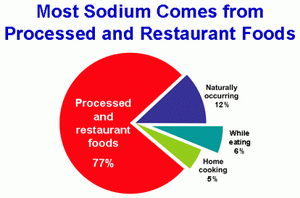|
Sodium – Chemical Element And Essential NutrientSodium is a chemical element with symbol Na and atomic number 11 on the periodic table of elements, but many people sometimes forget that it is an essential nutrient, which along with the chloride chemical element makes up the food preservative and enhancer salt, which is further enhanced to turn it into common table salt.
This is one nutrient that we get totally from food but that we get way too much of since only a very small amount is needed. Sodium is considered an electrolyte, which is a substance that can come apart in water in the form of charged particles that can conduct an electrical current. This is a property of the element that along with potassium is exchanged across cell membranes enabling the nervous system to transmit messages to and from the brain and making it possible for the muscles of the body to contract. Sodium is also referred to as a cation which is a particle that carries a positive charge, and this cation has a distribution in the extracellular fluid which is that fluid outside of and surrounding the cells, and working with potassium, the major cation ion in intracellular fluid, the fluid which is inside the cell and chloride the major extracellular fluid anion, a particle with a negative charge, these three electrolytes together maintain the distribution of water in the body at an appropriate level and maintain blood pressure. In addition, this mineral helps control the acidity of the body, and assists in the absorption of glucose the primary nutrient used by the brain for energy. Dietary Recommendations Not enough of the mineral is rarely a problem, but too much generally is, we really only need a few hundred milligrams/day. The adequate intake (AI) has been set at 1500 milligrams/day for adults. The upper limit of the daily value (DV) has been set at no more than 2,400 milligrams/day, which is equivalent to a little more than a teaspoon of table salt per day which is 2, 325 milligrams/day. Sources of the Mineral The largest amount of the mineral is consumed in the diet in the form of processed foods not table salt, and typically in the American diet we inject 3,000-6,000 milligrams/day.
The mineral is absorbed through the intestinal tract and it then travels throughout the body in the bloodstream. Fortunately the kidneys retain only the amount of the mineral that we really need and excrete the rest in the urine. Too Little Or Too Much Mineral When there is too little of the mineral in the blood then this is referred to as hyponatremia and usually results from prolonged sweating with replacement of water but not the mineral, severe diarrhea or vomiting. The symptoms of this condition resemble dehydration and the treatment is the same replacement of fluids with minerals. When too much of the mineral is present in the blood the condition is called hypernatremia, which can lead to edema or swelling and a rise in blood pressure, and this condition is generally seen in persons with congestive heart failure or kidney disease. If the kidneys are healthy and adequate amounts of water are consumed, then excess sodium is rapidly excreted. The primary condition that arises from prolonged consumption of too much salt over a period of time is hypertension, a persistent high blood pressure. Persistent high blood pressure is a major risk for heart disease, kidney disease, and stroke. Although the disease is treatable, the best course is to control the intake of salt in the diet to prevent the consequences of too much intake (more about hypertension later).
For other information on nutrition some great references are: • Nutrition – Fourth Edition by Paul Insel, Don Ross, Kimberley McMahon, and Melissa Bernstein • The Vitamin Alphabet – Your guide to vitamins, minerals and food supplements by Dr. Christiana Scott-Moncrieff MB, CHB, MFHOM
Nutrients In Food
|
What Are The Sources of Sodium?







